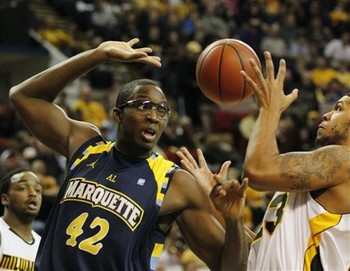Chris Otule & Kevin Laue Remind Us to Stop Complaining
Posted by rtmsf on January 6th, 2011The human body is an amazingly adaptable entity when faced with adversity. If it’s extremely cold, blood rushes from its extremities into the core to keep the central organs warm and functioning. If it’s too hot, buckets of sweat seep from its pores to act as an internal cooling mechanism. When injured, the fight-or-flight mechanism often makes a dangerous situation into a survivable one by buying time for the individual to get to safety. We all know these things to be true, and therefore it should be no surprise when we learn of astonishing people in the athletic realm doing astonishing things with their bodies. And yet we are.
Such was the case late last week when, during the Marquette-Vanderbilt game on ESPN2, commentator Mark Gottfried told the viewing audience that Golden Eagle center Chris Otule has only one functional eye. Come again? Most people, including many members of the Marquette fanbase, were not aware of the redshirt sophomore’s physical limitation, which begs the question of how Gottfried knew about it (did he recruit Otule while still at Alabama?) and why he chose a national television audience to out the player. Notwithstanding the possible HIPAA violation that Gottfried committed while on air, the bigger question is this: HOW ON EARTH DO YOU PLAY DIVISION ONE BASKETBALL WITH ONE EYE???
This is phenomenal. See, the beauty of having two eyes in our heads is that it provides us with what the smart folks call stereoscopic binocular vision, or essentially, the ability to see clearly in three dimensions. That third dimension relating to depth perception is the key, because it allows other animals an ability to gauge how far away their prey is and how fast it is going, while also allowing us human folks the convenient ability to accurately pass, catch and shoot a basketball while on the move. Now, with only one eye, a person can still gauge depth, but it becomes much more difficult, especially at close ranges. Even at farther lengths, it takes longer for a single eye to make determinations of relative distances, and the accompanying field of peripheral vision has been estimated as 25% smaller.










































